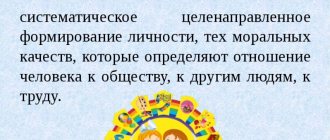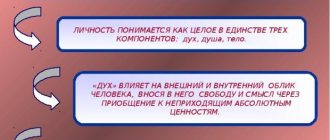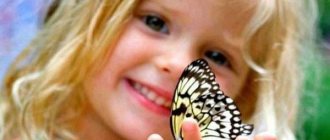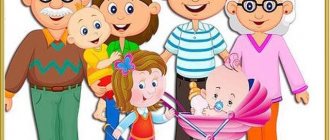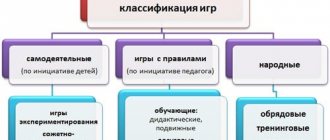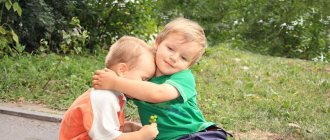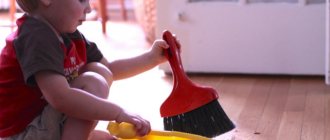Features of the formation of moral behavior in preschoolers article on the topic
Features of the formation of moral behavior in preschool children
annotation
The future of our Fatherland depends on the spiritual and moral potential of the younger generation, its ability to selflessly care for others and selfless love for their Motherland. Currently, Russia is going through one of the difficult historical periods. And the greatest danger facing our society today is not the collapse of the economy, not the change of the political system, but the destruction of the individual. Nowadays, material values dominate over spiritual ones, so children have distorted ideas about kindness, mercy, generosity, justice, citizenship and patriotism. Children are distinguished by emotional, volitional and spiritual immaturity. Forms of collective activity are gradually being lost. Appealing to the experience of humane pedagogy at the present time, when the process of spiritual revival of Russia is underway, is especially relevant, since society and the state are in dire need of educational models that provide spiritual and moral components in the content of education.
Keywords
Moral norms are the totality of all types of relationships between people that arise in the process of living together. Moral norms are a social concept, as they affect the problem of an individual’s living in human society. They, in essence, represent the requirements that society places on each individual person.
Morality - socially accepted ideas about good and bad, right and wrong, good and evil, as well as a set of norms of behavior arising from these ideas
Personal example is a method of education based on the imitation of children and youth by the best examples of human life and activity. These people, whose actions, words and attitudes are copied and repeated by children, can be, first of all, the father and mother, people close to the family, relatives, and friends of the family.
The culture of communication is part of the culture of behavior, which is expressed in a person’s speech, in the mutual exchange of remarks and conversation. The assimilation of communication norms is the result of upbringing.
The principles of moral education are the basic, initial provisions that determine the content, methods and forms of organization of the entire system of moral education in schools and preschool institutions. They express the basic requirements for the process of moral education.
Features of the formation of moral behavior in preschool children
A person as an individual develops throughout his life, however, the most important personal properties and abilities, the psychological foundation of the individual, are formed in preschool age. The entire make-up of his personality and, in many ways, his personal destiny depend on how a person’s childhood was. [5. from 66]
Pedagogy considers the active, purposeful process of forming moral consciousness, moral feelings and habits, and moral behavior from the first years of a child’s life as moral education.
Moral education means to develop moral feelings, habits and moral consciousness in children.
A spiritually enriched surrounding reality is the first condition for the moral development of a child’s personality. The core of morality consists of norms and rules of behavior. They manifest themselves in people’s actions, their behavior, and govern moral relationships between children and adults.
The mental life of a child begins very early. It is built according to the laws of the developing reflective ability of the psyche. It becomes clear why the child begins to copy, reflect in actions and words, emotional manifestations and actions the world in which he lives. He will be what his social environment makes him. [5. p. 71].
The child’s first moral feelings develop in the family as a response to the love and care with which he is surrounded, and extends to a narrow circle of the closest people.
At the age of 3-4 years, the child’s attitude and feelings towards people and phenomena in the surrounding life are still very unstable. A positive attitude often gives way to a negative one. [6.p 165]. Thanks to upbringing, the moral feelings and actions of a 4-5 year old child become more stable. Children share toys of their own free will, show responsiveness, care, and help each other. The moral feelings of children of this age become more effective. Adults teach children to take care of babies, a sick friend, etc.
At the age of 6-7 years, children begin to understand the interests of their peers and other people. Children at this age begin to understand why it is necessary to help the little, old, sick, and weak.[6.p. 166]. However, throughout preschool age, the child’s feelings are characterized by spontaneity and instability. Therefore, it is important to direct educational work to expand feelings, make them more stable and deeper.
At preschool age, moral habits are successfully formed. The assimilation of habits begins at an age when one cannot count on a conscious attitude to the demands and instructions of adults. This feature of moral development was pointed out by V.G. Belinsky. He warned: “The younger the child, the more direct his moral education should be, and the more he should not be taught, but accustom him to good feelings, inclinations and manners, basing everything primarily on habit, and not on premature and, therefore, unnatural development.” concepts.”[1.p.220-221]
If at a younger preschool age children are already taught everyday culture, politeness, playing together, and obedience, then at an older preschool age these habits are reinforced and more complex habits of collective games, work, activities, and careful execution of assignments and responsibilities are developed. Children are taught a certain form of showing help, respect for adults, how to make a request and how to thank them.
But still, a characteristic feature of children in preschool age is that consciousness does not yet have a decisive force in their moral behavior.[6.p. 167]. In working with preschoolers, you can achieve some achievements in instilling consciousness, reasonable actions, the ability to behave, and rules of behavior. This is possible when explanations and moral motivations for adults’ demands are moderate, tactful, and specific. Children do not like dry moralizing and usually do not listen.[6.p. 168].
Principles of moral education.
The moral education of preschool children is based on the following principles:
- purposefulness of all work on raising and teaching children;
— education in a team;
— taking into account the age and individual characteristics of children;
— exactingness towards children combined with respect for the individuality of each child;
- systematicity, consistency and unity of requirements and educational influence.[6.p. 168].
Moral education is carried out taking into account the age and individual characteristics of children.[6.p. 169]. For each age, specific tasks of moral education are determined. Taking into account the age characteristics of children, appropriate methods and techniques of moral education are used.
The moral education of a younger preschooler is based on imitation of example. At this age, the first signs of cultural behavior, the initial skills of playing together, and independence are developed. Young children up to 2.0-2.5 years old are able to understand and experience basic moral feelings. They have access to the language of higher human emotions, but they have difficulty perceiving and understanding the verbal language of morality. The emergence of moral feelings genetically precedes the formation of moral judgments and actions in a child, therefore moral education should begin with them, especially since at an early age the need for communication with people around them is quite developed in children.[2.p.425].
In the moral education of children of senior preschool age, more complex tasks are set, explanations, stories, observations of the surrounding life, and reading books are used.
Of great importance in the moral education of children is the systematicity, consistency and unity of the educational influences of the kindergarten and the family.[6.p. 171].
The unity of pedagogical influences helps to form moral qualities, strengthen their moral habits, and, conversely, the inconsistency of educational methods between parents and educators has a harmful effect on them, causing contradictions in their consciousness and behavior.
Educational influences on children should be applied in a systematic and progressive manner.
Children gradually become accustomed to the idea that they should help adults and do something useful for the team. Therefore, from an early age it is necessary to create such conditions for children so that they not only accept love and care for them with gratitude, but also be attentive to their parents, teachers, and other children. It is necessary for children to perform simple duties in the family, in kindergarten, and gradually learn to somewhat limit their desires.
The tasks of moral education of children can be solved taking into account their specificity in relation to preschoolers. Due to this specificity, it is recommended to use several methods of moral education:
-example of parents and educators (adults), examples from the surrounding life;
— teaching children to moral actions and behavior;
- the word of the educator (adult): persuasion, explanation, encouragement;
- influence on the feelings and consciousness of children through art and fiction.
All types of art (music, singing, painting, literature), accessible to children’s perception and understanding thanks to imagery, are a powerful means of moral education. Art influences the feelings and consciousness of children. The emotionality of works of art is extremely valuable in educational terms. By perceiving this or that work of art, the child becomes, as it were, an accomplice in the events described, as a result of which his feelings and actions are ennobled.[6.p. 175].
The influence of the example of adults and a conscious attitude to public duty, the nobility of actions are especially great - a huge educational force that influences the behavior and moral character of children. Examples of a serious, responsible attitude of adults to work, their help for each other, and honesty have a great influence on children, educating their attitude towards work, responsibilities, and people.
In raising children, it is important to use praise, encouragement of the child’s good actions and censure of bad ones.
It is important to cultivate a sense of collectivism in children, and the condition for cultivating this feeling is an atmosphere of love, care and attention, sensitivity in the relationships of people among whom the child lives and by whom he is raised.
Interesting games, activities, entertainment, and common work contribute to the accumulation of pleasant impressions in children; the unification of children by common interests, common experiences, and close to each other is achieved.
The personality of each child, concern for her moral development - today and in the future - requires daily attention from adults.[3.с5].
When solving the problems of education, it is necessary to rely on the rational and moral in a person, to determine the value foundations of one’s own life, and to gain a sense of responsibility for preserving the moral foundations of society. Moral education helps with this.
Bibliography
- Belinsky V.G. Selected pedagogical works / APN RSFSR,
1948
- Nemov R.S. Psychology / M.: Vlados, 1998.
- Moral education in kindergarten / under. ed. V.G. Nechaeva, T.A. Markova. – M.: Education, 1975.
- Panina S.M. Spiritual and moral formation of preschool children: notes on direct educational activities / Volgograd: Teacher, 2016.
- Magazine "Preschool Education" No. 2, 1991.
- Surovtseva A.V. Preschool pedagogy / M.: 1962.
Formation of moral qualities: it all depends on age
For children of different ages, emphasis should be placed on different points. The following is very important:
- For the little ones - to make them feel the love of others and teach children to express it; gently and carefully condemn aggression.
- For younger preschoolers – teach to strive for success and adequately perceive failures; The coincidence of the presented theory and the example of adults is very important.
- For middle preschool children - teach how to solve logical verbal problems, guided by the concepts of morality; the ability to understand and perceive the feelings of others.
- For older preschoolers, teach how to analyze positive and negative actions.
Theory is good, correct and important. But literary beautiful phrases or, conversely, unpleasant examples from life often repel children and make them stressed. We must teach how to apply theory in practice. So that it doesn’t turn out like this: the child knows how to act, but it doesn’t find application in life. And he acts by inertia, as he is used to.
We need to let him try to act correctly and tell him what this is exactly: help, kindness, support, politeness, etc. After all, it often turns out that an adult says that he loves someone or something (mother, friends, animals), but does not show it in action. And if you love your mother, fold your clothes neatly, make your bed and put away your toys. Help grandma find medicine and slippers. Change the water in your dog's bowl or add some food.
Moving from theory to practice
It is best to impart knowledge through games and combined activities. Topics can be very different: friendship, family, charity, respect for nature, respect for older people, patriotism, good and bad, what selflessness and kindness are, politeness, sympathy, initiative, charity, etc.
There is no need to try to embrace the immensity; it is better to take small steps and build one lesson around only one topic. You need to come up with a concept, select practical tasks, cartoons, games, rhymes, didactic
Thank you for your attention!
The process of moral education is a set of consistent interactions between the teacher and the team, aimed at achieving the effectiveness and quality of pedagogical activity and the proper level of moral education of the child’s personality. Morality is an integral part of an integrated approach to the education of the individual “The formation of morality is nothing more than the translation of moral norms, rules and requirements into knowledge, skills and habits of behavior of the individual and their strict observance,” writes I.F. Kharlamov. Morals are those standards and norms that guide people in their behavior and in their everyday actions. Morals are not eternal or immutable categories. They are reproduced by the force of habit of the masses, supported by the authority of public opinion, and not by legal provisions. At the same time, moral requirements, norms, and rights receive a certain justification in the form of ideas about how to behave in society. Moral norms are the expression of certain attitudes prescribed by the morality of society to the behavior and activities of an individual in different areas. Moral education is a purposeful process of developing high consciousness, moral feelings and behavior in the younger generation in accordance with the ideals and principles of morality. The main function of moral education is to form in the younger generation a moral consciousness, stable moral behavior and moral feelings that correspond to the modern way of life, to form an active life position of each person, the habit of being guided in their actions, actions, and relationships by feelings of public duty. In modern science, moral education is considered as one of the most important aspects of the overall development of preschool children. It is in the process of moral education that a child develops humane feelings, ethical ideas, cultural behavior skills, social and social qualities, respect for adults, a responsible attitude to carrying out assignments, and the ability to evaluate his own actions and the actions of other people. Over time, the child gradually masters the norms and rules of behavior and relationships accepted in human society, appropriates, that is, makes his own, his own, methods and forms of interaction, expressions of attitude towards people, nature, and himself. The result of moral education is the emergence and approval in the individual of a certain set of moral qualities. And the more firmly these qualities are formed, the fewer deviations from the moral principles accepted in society are observed in an individual, the higher the assessment of his morality by others. As is known, preschool age is characterized by increased susceptibility to social influences. The strength and stability of a moral quality depend on how it was formed, what mechanism was used as the basis for pedagogical influence.
Let us consider the mechanism of moral development of personality. For the formation of any moral quality, it is important that it takes place consciously. Therefore, knowledge is needed on the basis of which the child will form ideas about the essence of moral quality, its necessity and the advantages of mastering it. The child must have a desire to acquire a moral quality, that is, it is important that motives arise for acquiring the corresponding moral quality. The emergence of a motive entails an attitude towards quality, which, in turn, shapes social feelings. Feelings give the formation process a personally significant coloring and therefore influence the strength of the emerging quality. But knowledge and feelings generate the need for their practical implementation - in actions and behavior. Actions and behavior take on the function of feedback, allowing you to check and confirm the strength of the quality being formed. Thus, the mechanism of moral education emerges: (knowledge and ideas) + (motives) + (feelings and attitudes) + (skills and habits) + (actions and behavior) = moral quality. This mechanism is objective in nature. It always manifests itself during the formation of any (moral or immoral) personality trait. The main feature of the mechanism of moral education is the absence of the principle of interchangeability. This means that each component of the mechanism is important and can neither be excluded nor replaced by another. At the same time, the action of the mechanism is flexible: the sequence of components can change depending on the characteristics of the quality (its complexity, etc.) and the age of the object of education. The first group of tasks of moral education includes the tasks of forming its mechanism: ideas, moral feelings, moral habits and norms, and behavioral practices. Each component has its own formation characteristics, but it must be remembered that this is a single mechanism and therefore, when forming one component, an influence on other components is necessarily expected. Education is historical in nature, and its content varies depending on a number of circumstances and conditions: the demands of society, economic factors, the level of development of science, and the age capabilities of those being educated. Consequently, at each stage of its development, society solves different problems of educating the younger generation, that is, it has different moral ideals of a person. So, the second group of tasks of moral education reflects the needs of society for people who have specific qualities that are in demand today. New traits appear in children in relationships with adults and peers. Children actively show interest in meaningful communication with adults. The authority of an adult and his value judgment continue to play a serious role in behavior. Growing independence and awareness of behavior lead to the development of the ability to be guided in actions by learned moral standards. Internal “ethical authorities” arise, which begin to determine the actions of the older preschooler. Children show an active desire to communicate with peers in various types of activities, as a result of which a “children’s society” is formed. This creates certain prerequisites for the development of collective relationships. The unity of education of moral consciousness and behavior A.S. Makarenko attached great importance, believing that children should be armed with a theory of morality. At the same time, he argued that cultivating the habit of correct behavior is much more difficult than cultivating consciousness. Education of moral behavior is the formation of moral actions and moral habits. An action characterizes a person’s attitude to the surrounding reality. In order to evoke moral actions, it is necessary to create appropriate conditions and organize the lives of students in a certain way. Moral habit is the need to perform moral actions. Habits can be simple when they are based on the rules of community life, culture of behavior, discipline, and complex when the student develops a need and readiness to perform an activity that has a certain meaning. For the successful formation of a habit, it is necessary that the motives by which children are encouraged to act are significant in their eyes, that the children’s attitude towards performing actions is emotionally positive and that, if necessary, children are able to show certain efforts of will to achieve results.
Conclusions:
Preschool age is a period of intensive formation of the psyche based on the prerequisites that developed in early childhood. Along all lines of mental development, new formations of varying degrees of severity arise, characterized by new properties and structural features. They occur due to many factors: speech and communication with adults and peers, various forms of cognition and inclusion in various types of activities. Along with new formations in the development of psychophysiological functions on the basis of individual organization, complex social forms of the psyche arise, such as personality and its structural elements, the subject of communication, cognition and activity and their main components - abilities and inclinations. Thus, considering the theoretical aspects of moral education and the formation of a culture of behavior, we came to the conclusion that the problem of moral development of the individual has existed for a very long time and many discoveries have been made in this area. The process of moral education has its own specifics and difficulties in organization, however, having mastered the necessary psychological and pedagogical knowledge, an adult is able to influence the child and purposefully form moral ideas and a culture of behavior.
Unintentional lies
- the child’s tendency to fantasize as an element of play, an extremely subjective depiction of events, a mixture of the real and the fictional;- easy self-hypnosis, readiness to see what is desired accomplished, what has been started completed.
- do not encourage or encourage the child to come up with new ideas, restore the truth, tactfully and carefully;- include the child in games and activities where his desire to demonstrate his strength, dexterity, ingenuity, etc. would find intensive use.
Moral development in preschool age
At preschool age, the most favorable conditions are created for the moral development of children. During this period, the child’s system of relationships with adults and peers expands and restructures, types of activities become more complex, and joint activities with peers arise. Let us recall that in early childhood the child mastered a wide range of objective actions and “discovered” ways of using objects. This “discovery” inevitably led him to an adult as a bearer of a social way of performing actions, as a model with which to compare himself. The child looks closely at the world of adults, beginning to highlight the relationships between people in it. A preschooler comprehends the world of human relations, discovers the laws by which human interaction is built, that is, norms of behavior. In an effort to become an adult, a preschooler subordinates his actions to social norms and rules of behavior.
The leading type of activity is role-playing play, where the child models behavior, actions, and relationships among adults. It brings to the fore the relationships between people and the meaning of their work. By performing roles, the child learns to act in accordance with the moral standards accepted in human society.
The moral development of a preschooler includes three interrelated areas. In the sphere of moral knowledge, judgments, ideas, that is, the cognitive sphere, children master various aspects of social moral consciousness, and above all an understanding of moral requirements and criteria for moral assessment. The child learns to voluntarily follow moral standards, even if its violation is associated with personal gain and the child is confident of impunity. Thus, having mastered moral behavior, the child is able to make the right moral choice not in words, but in action. In the sphere of morally valuable experiences, the child develops morally valuable and morally approved relationships with other people. Thus, the child develops humanistic, altruistic feelings and attitudes, for example, attention to the needs and interests of others, the ability to take them into account, sympathy for other people's troubles and joys, as well as the experience of guilt when violating norms.
All moral norms are characterized by the fact that they reinforce a social way of behavior, which preschoolers express as follows: “You can’t deceive adults,” “You can’t offend little ones,” etc. That is, children state what can be done and what cannot be done. We can talk about the formation of an understanding of a moral norm if the child explains why the norm must be observed.
In preschool age, there are completely different levels of such understanding. The younger the child, the more often he explains the need to fulfill the norm, referring to the possible consequences for himself if it is observed or to the demands of adults, for example: “We must tell the truth, otherwise they will find out and punish us,” “We must share toys. And then someone will give it to you too.” At 5-7 years old, a child understands the social meaning of a moral norm and realizes its objective necessity for regulating relationships between people.
So for an older preschooler, the interests and desires of another person begin to play an increasingly important role. Children of this age use words in their speech that denote moral qualities and their antipodes (kind, brawler, greedy, honest, sneak, etc.), but associate them with a specific situation from their own experience, which is explained by the specific imagery of children's thinking.
If a preschooler clearly sees the consequences of following or violating a norm, then it is easier for him to understand its content and apply it to himself. The more specific the norm, the closer it is to the child’s own experience, the easier it is to understand.
It is no coincidence that greed is considered one of the most negative qualities in a preschooler, because the main reason for conflicts between children is that everyone wants to get an attractive object. If the toy is not available, the child experiences strong negative emotions. The child not only learns and understands the norm, but also assigns it to a certain category: “good” or “bad.” He seeks to evaluate her. In older preschool age, the development of moral assessments is inextricably linked with how an adult evaluates the actions of children. Thus, those qualities that an adult more often identifies and evaluates are easier to understand and evaluate. The older preschooler becomes the initiator of conversations with parents and educators, the topic of which can be designated as follows: “What is good, what is bad.” As proof, we present the data of R.Kh. Shakurov.
Fiction plays an important role in the formation of moral judgments and assessments in children. Research by A.V. Zaporozhets, which were devoted to the study of preschoolers’ perception of fairy tales, allowed us to highlight the following features. The child is not satisfied with uncertain situations when it is not known who is good and who is bad. Children immediately strive to identify positive characters and unconditionally accept their positions. And in relation to everyone who interferes with the implementation of their plans, they take a sharply negative attitude. When listening to a literary work, the preschooler takes the position “inside it.” He strives to imitate his favorite heroes. This is how mechanisms of moral identification arise, internal action in the imaginary plane, and the child’s personal experience is enriched, because he actively experiences events in which he did not participate. Literary characters are fixed in the child’s mind in accordance with a certain characteristic. It is very difficult for a preschooler to classify himself as a negative character. Thus, a child, even realizing that he has violated a moral norm, cannot identify himself with Karabas, but claims that he acted like Pinocchio (S.G. Yakobson).
Children 3-4 years old are not aware of the motives of their attitude towards the hero, simply assessing him as “bad” or “good”.
At 3-4 years old, a child can already give a correct moral assessment, without comprehending the situation, but transferring his positive or negative attitude to the specific actions of the characters. The attitude towards the hero determines the child’s assessment of him. At the age of about 4 years, a discrepancy between the emotional and moral attitude towards the hero may be observed. At the age of 4-5, the concepts of “bad” and “good” are formed. Then an assessment of the hero arises based on the content of his actions. The child penetrates into the interaction of the characters and takes into account not only who performed the action, but also to whom it was directed. After 4 years, with the development of empathy and assistance to the hero, moral argumentation arises. Now children point out the social significance of actions. Thus, actions in the imaginary plane help the child to come to an understanding of the motives of behavior, and the emotional attitude towards the hero begins to separate from the moral assessment of his actions.
Older preschoolers understand the moral side of folk tales. The negative moral side of the heroes’ actions causes sharp protest and indignation. Children consciously stand on the side of good.
At the age of 3-7 years, children develop ethical standards-models that contain a more or less generalized idea of positive or negative behavior in life situations. A preschooler correlates his behavior not only with a specific adult, but also with a generalized idea. That is, the external pattern of adult behavior moves into the internal plane, expanding the possibilities for the moral development of the individual.
An older preschooler develops generalized ideas about friendship, mutual assistance, devotion, and kindness.
As an example, let us give a fairy tale invented by Maxim D. (5 years 9 months).
“Once upon a time there was an evil king. He didn't like beggars and always killed them. But one day a Russian knight appeared and said to the king: “What do you order?” - “Kill all the beggars.” And the Russian hero said: “I am kind and do not kill beggars.” -"Ah well! Let's fight." And the king knocked the saber out of the hero’s hands. “I may die, but I will not kill.” The king wanted to swing his hand to cut off his head. But all the beggars began to stab him with sabers. And the king died. And the Russian hero said: “Thank you for coming to the rescue.” And suddenly one beggar rolled into the water. And he rushed after him. He sees the underwater kingdom. He sees one crown lying there. And he began to pull her out. But suddenly a huge man with a tail appeared: “Why are you touching my crown? Otherwise I’ll kill you with a trident.”
The Russian hero said: “Don’t punish me, but bring me to your kingdom. Give me something to drink and feed." “Okay,” said the sea king. I fed him and gave him something to drink. The hero said: “Find me a wife.” And the king replied: “Okay. I have three daughters. Choose the one you need." - “To me - the one with blue eyes. And her name is Anastasia.” The king of the sea turned her into a girl. Instead of a tail, she had legs: “This is your fiancé.” - “Goodbye, daddy.” I’ll be waiting for you very much.” And they got married."
At preschool age, the moral ideas of a preschooler influence his everyday life. In real life, the child demonstrates attempts to perform moral actions and resolve conflicts, showing an emotional focus on others.
However, moral standards, even those that the child knows well, do not immediately begin to guide his behavior. Initially, they are performed only at the request of an adult or in his presence, and are easily violated by a child. Moreover, the baby does not notice this violation and, while negatively assessing such behavior in general, does not apply the negative assessment to himself.
Having mastered the norm, the child first of all begins to control his peer. It is easier for him to see and evaluate the presence of moral qualities and the fulfillment of standards by a peer than by himself. Very often he correctly assesses the fulfillment of moral standards by his comrades and is mistaken about himself. The desire to establish knowledge of a moral norm leads to the appearance of special statements addressed to adults - “complaints-statements”, which contain messages about violation of the rules by one of the children. A child, turning to an adult, wants to confirm whether he correctly understands the norm or rule. Gradually, evaluating a peer, comparing himself with him, listening to the assessment of his actions by adults and friends, the child approaches real self-esteem.
Older preschoolers increasingly display not pragmatic behavior, when a moral act is associated with self-interest, but selfless behavior, when behavior does not depend on external control, and its motive is moral self-esteem.
At the age of 5-7 years, preschoolers move from spontaneous to conscious morality.
For them, a moral norm begins to act as a regulator of relationships between people. An older preschooler understands that the norm must be observed for collective activity to be successful. There is no need for external control over compliance with the norm on the part of an adult. The child’s behavior becomes moral even in the absence of an adult and if the child is confident in the impunity of his action and does not see any benefit for himself.
Thus, the development of moral judgments and evaluations is necessary, but not sufficient for moral development. The main thing is to create conditions when the norm of morality begins to regulate the child’s actual behavior, that is, to establish a connection between moral consciousness and moral behavior. Only in the presence of such a connection does the norm become a motive for behavior and perform an inducing, meaning-forming function. Then the child’s consciousness moves from the result to the process of fulfilling the norm, and he follows the norm for its own sake, because he cannot do otherwise. And compliance with the norm acts as emotional reinforcement for the preschooler. The relationship between moral consciousness and behavior is established when the child is trained in moral actions, placed in a situation of moral choice, when he himself decides what to do: go for an interesting walk or help an adult; eat the candy yourself or take it to your mother; play with a new toy or give it to a younger one. By choosing to adhere to the norm, overcoming immediate desires and sacrificing his own interests in favor of another in order to please him, the child receives pleasure from the fact that he did the right thing. Gradually, this behavior becomes a habit and the need to comply with the norm appears.
In the development of moral behavior, the example of an adult also plays a vital role. No wonder V.A. Sukhomlinsky emphasized: “A child is a mirror of the moral life of his parents.” The positive example of parents helps the child easily and unobtrusively learn to live in accordance with the norms accepted in society. A norm that is only declared but not observed by an adult will never influence the child’s actual behavior. Moreover, the baby will understand that moral standards can be violated with impunity, and it is not necessary to observe them. This is how opportunism and maneuvering are born. The child strictly fulfills the norm in some conditions and violates it in others, without feeling guilty.
One can observe two modes of behavior that are fundamentally different from each other when a preschooler violates moral norms. First, the norm is violated unconsciously when the child acts under the influence of situational desires. This behavior appears as an age-related feature. This indicates that the mechanisms of voluntary behavior are unformed and that the norm has not yet become an internal psychological authority, but remains an external requirement. A child, being at the mercy of momentary desires, commits negative actions without thinking about the consequences.
Secondly, with a conscious violation of the norm, the child becomes aware of the contradictions between his behavior and the socially approved model. In this case, we should talk about misconduct. To show their nature, let us compare two very similar in appearance, but in fact radically different forms of behavior: misconduct and pranks. A.A. Lyublinskaya showed their differences.
Pranks are characterized by a benevolent attitude towards people. The child is active, proactive, inventive, and his behavior, painted in a bright positive emotional tone, is selfless. There are different types of pranks. At an early age, pranks appear, acting as a variant of the game that serves as their source. They are typical for children under about five years of age. The child focuses on the actions of an imaginary character. Pranks become an end in themselves, a source of intense positive emotions, displacing the plot, when the game plot is preserved as a background and serves as a kind of justification for the actions performed and their consequences.
At the age of 4-7, children exhibit pranks, the motive of which is the question “What will happen if...?” (open the tap and close the flow of water with your finger). Their source is the children’s cognitive attitude towards the environment and the desire to explore it. Such pranks are more common among enterprising children; they are based on the positive traits of an emerging personality: activity, initiative, curiosity.
Throughout preschool childhood, pranks motivated by the question “What can I?” are noticeable. Their source is the development of independence. Such pranks border on mischief. And they proceed according to this scheme: the child breaks the rules and waits for the adult’s reaction. So he tests his strength, asserts his “I”, tries, as it were, to outline the circle of what is permitted.
The basis of most misconduct is an inept, but very ardent desire to protect one’s “I” from experiences, infringements and insults. They are caused by frequent punishments, unmotivated prohibitions, shouting, offensive nicknames, ridicule, lack of love and communication with adults and peers, a feeling of abandonment and uselessness. Let us emphasize that they appear only when the child cannot positively assert himself due to the adult’s incorrect position towards him. The kid drew a picture, but the teacher didn’t notice and praised the other one. Then the child tore up someone else’s drawing and was noticed by an adult. Repeatedly, misconduct forms a style of behavior, is reinforced and turns into a habit. They form negative character traits. Let's consider some of them, the most common among preschoolers: stubbornness, deceit, pugnacity.
Stubbornness manifests itself in the fact that the child insists on his demand, even if he understands its absurdity and impossibility. Often children deliberately make demands that an adult cannot fulfill. Stubbornness most often occurs when an adult limits the child’s capabilities and does not allow him to act independently and express his desires. “He’s still small,” some parents say and strive to do everything for the child. “He’s already big,” others say and erect a whole battery of prohibitions, often without taking into account age and individual capabilities. Often a stubborn child cannot refuse the initial demand. The main reasons for stubbornness include the child’s protest against unfair treatment and humiliation; tactlessness of adults; unreasonable restriction of independence and too strict attitude towards the child; ignoring his personal desires.
The most common reasons for children's lies are fear of punishment and a negative example from an adult. It is characteristic that a lie always has some kind of selfish motive, a motive of utilitarian gain, which is what differs from children’s fantasy. The desire to experience and act in an imaginary situation, the need for independence, self-affirmation, the claim to recognition lead to children's fantasies in which the child exaggerates his capabilities, for example, talks about how he visited different countries, saved people from floods, etc.
Children most often draw stories from films, stories from adults, and children's books. It seems that he himself believes in the authenticity of the images created in his imagination. But in the described case, the child does not pursue any benefit, and therefore such a distortion of reality cannot be considered a lie. Fantasizing should include children's stories about non-existent animals that they care for, about younger brothers and sisters with whom they play. The reason for writing these stories is a lack of communication with adults and peers or dissatisfaction with it. Pugnacity most often occurs in hyperactive children who do not find any other use for their energy in any activities or games. Pugnacity is a consequence of the fact that the child does not know how to communicate, establish positive relationships with friends, and then there is a desire to offend others. The child begins to extend this form of behavior not only to his offenders, but also to the small, weak, and defenseless. He takes pleasure in being feared. The feeling of one's strength leads to even greater pugnaciousness and to an even greater deterioration in relationships with peers. The cult of power in the family and the wrong attitude of adults lead to pugnacity: “Give back!”, “Only the strong are respected.”
In preschool age, the influence of an adult’s assessment on children’s behavior increases, since the adult acts as a model, a standard with which the child compares himself and his actions.
At 2-3 years old, children perform positive actions at the direction of adults, in order to fulfill their requirements. Limitation of one's desires by children rarely occurs and only under the influence of sympathy or sympathy. While performing objectively positive actions, children do not realize their necessity and significance for other people. At the age of 3, based on the moral assessment of an adult, children establish a connection between “good” and “bad” with their actions and classify their actions into the appropriate category. They enjoy being rated “good.”
A positive moral assessment by an adult gives a positive connotation even to those actions that were usually performed by a child with complete indifference.
When assessing a child’s actions, an adult, with the help of a positive assessment, fixes the correct way of behavior, and with the help of a negative one, he destroys the negative way. The effectiveness of the assessment and its influence on the moral development of the child directly depends on the ability of the teacher and parents to exert an evaluative influence.
An adult's assessment must meet certain requirements, that is, be:
- objective and at the same time tactful, therefore, the positive aspects of an action are first highlighted, the negative ones are talked about as if in passing, but so that the child understands what exactly the adult is dissatisfied with. It is not the child himself who should be assessed, but his misconduct. Blame should be resorted to in exceptional cases, showing how to act;
- focused on the child’s own behavior, and not on comparing him with other children, so as not to humiliate him in the eyes of adults and not to destroy joint activities;
- differentiated, since general assessments do not provide anything for personal development.
- systematic, and not given from case to case;
- including a combination of verbal and non-verbal methods of influence.
Preschoolers are especially sensitive to the latter. The ratio of different assessment methods depends on the age, individual characteristics of the pupils, and the situation.
Features of the moral development of children in preschool age:
- children develop their first moral judgments and assessments; initial understanding of the social meaning of a moral norm;
- the effectiveness of moral ideas increases;
- conscious morality arises, that is, the child’s behavior begins to be mediated by a moral norm.
